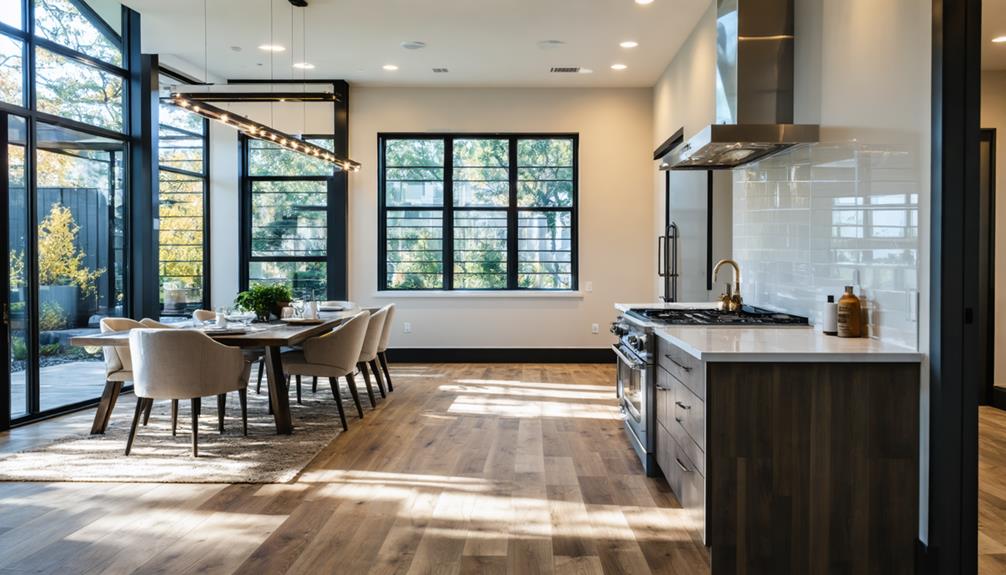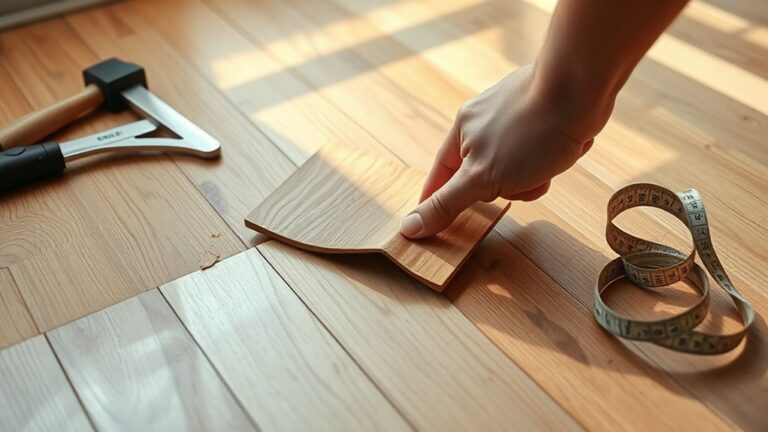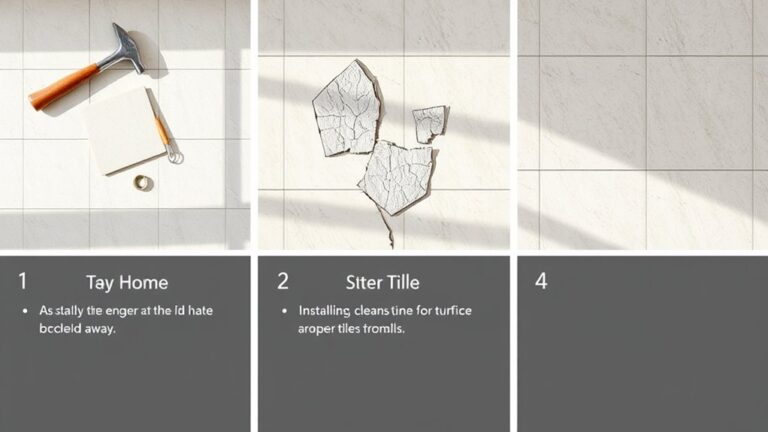Installing luxury vinyl plank (LVP) flooring in your kitchen or bathroom is an excellent choice due to its waterproof and durable properties. Start by ensuring your subfloor is clean and level, then acclimate the planks for at least 48 hours. Use an underlayment for comfort and sound absorption, adhering to expansion gap guidelines to prevent warping. Seal edges at intersections to protect against moisture and maintain a cohesive design with colors that complement other areas. Regular maintenance, including sweeping and damp mopping, will keep your floors looking great. There's even more to explore about proper installation techniques and care.
Advantages of LVP Flooring
When considering flooring options, what makes LVP flooring stand out? One of the most significant advantages is its waterproof nature. LVP's ability to resist moisture makes it an exceptional choice for wet environments like kitchens and bathrooms. Unlike traditional wood or laminate flooring, LVP won't warp or become damaged when exposed to spills or humidity, providing reliability and peace of mind.
In addition to its moisture protection, LVP is incredibly durable. It resists scratches, stains, and dents, making it ideal for high-traffic areas. Whether you're dealing with kids, pets, or frequent gatherings, LVP can handle the wear and tear without compromising its appearance. This durability guarantees you won't need to replace your flooring as often, saving you both time and money.
Another compelling aspect of LVP is its easy maintenance. Regular sweeping and the occasional damp mop are all that's required to keep it looking pristine. This low-maintenance requirement is especially beneficial in busy spaces where cleanliness and convenience are priorities.
Installation Guidelines
Installing LVP flooring requires careful preparation to guarantee peak performance and longevity. Before you install vinyl plank flooring directly in kitchens and bathrooms, make sure the subfloor is clean, dry, and level. Acclimate the planks to room temperature for at least 48 hours to allow for ideal expansion and contraction. This step is vital for ensuring proper installation.
Use an underlayment to enhance comfort and sound absorption, and adhere strictly to the manufacturer's guidelines regarding expansion gaps. It is important to caulk edges where the flooring meets walls, particularly in moisture-prone areas like bathrooms, to prevent water intrusion and damage. In these environments, the water resistance of LVP is a significant advantage, but proper sealing is still necessary to maximize durability.
Avoid installing LVP over existing flooring unless the manufacturer explicitly recommends it. This practice can compromise the performance and longevity of your new floor. If you want a seamless aesthetic throughout your space, consider the benefits of continuous installation of LVP throughout the home. This not only maintains visual consistency but also eliminates awkward changes between different flooring types.
Common Mistakes to Avoid
One of the most common pitfalls during LVP installation is neglecting the importance of proper moisture management in bathrooms. Without adequate sealing and caulking, water damage can occur, leading to costly repairs down the line. Here are a few mistakes you'll want to avoid:
- Ignoring moisture risks: Always assess potential sources of water intrusion and make certain that seams are sealed properly.
- Disregarding uniform expansion gaps: Failing to leave adequate gaps can lead to warping or buckling, particularly in moisture-prone environments like kitchens and bathrooms.
- Mishandling connections between different flooring: Plan these junctions carefully to avoid awkward or unappealing connections that can disrupt your space's aesthetic.
- Mixing incompatible flooring types: This can clash with existing design elements, disrupting visual flow and creating a disjointed appearance.
- Overlooking cohesive design: Make certain that the colors and patterns you choose complement each other, maintaining a harmonious look throughout the area.
Design Compatibility
Achieving a cohesive look throughout your home goes beyond avoiding common installation pitfalls; it also involves ensuring design compatibility among various spaces. When selecting LVP, consider colors that complement adjacent rooms. This enhances overall design compatibility and creates a unified aesthetic that flows effortlessly from one area to another. LVP's versatility allows it to mimic natural materials like wood and stone, making it suitable for both modern and traditional designs in kitchens and bathrooms.
To promote visual cohesion, opt for continuous flooring installations where LVP shifts seamlessly from room to room. This approach eliminates jarring shifts between different flooring types, making your living space feel more connected. In bathrooms, choosing lighter colors can enhance the perception of space, making smaller areas feel larger and more open.
It's essential to coordinate LVP styles with existing cabinetry and fixtures to maintain a harmonious design. Mismatched styles can lead to visual clashes, detracting from the overall aesthetic you're aiming for. Consider the design options available, and think about how they'll integrate with your current decor.
Alternative Flooring Options
While LVP is a popular choice for flooring, several alternative options can enhance your home's aesthetic and functionality. Each alternative brings unique benefits, especially in areas like kitchens and bathrooms where moisture and durability are key factors.
Here are some alternative flooring options to assess:
- Large-Scale Marble Look Tiles: They offer a high-end aesthetic and are both durable and waterproof.
- Charcoal Herringbone and Hex Tiles: Their unique patterns add character and a timeless design to your space.
- Sheet Vinyl: Fully waterproof and easier to install, it provides a seamless look, reducing water penetration risks.
- Ceramic or Porcelain Tiles: Known for their durability, they withstand moisture and are ideal for high-traffic areas.
- Terracotta or Saltillo Tiles: These add rustic charm but may require more maintenance and sealing than LVP or modern tiles.
When evaluating these alternative flooring options, think about your specific needs. Large-scale marble look tiles can elevate a bathroom's elegance, while sheet vinyl might be the practical choice for a busy kitchen. Ceramic or porcelain tiles offer durability that stands up to heavy foot traffic, while terracotta tiles bring a warm, earthy vibe but may demand more upkeep.
Ultimately, your choice should reflect your lifestyle, aesthetic preferences, and the level of maintenance you're willing to commit to. Each option can provide a durable, waterproof surface that enhances your home's beauty and functionality.
Essential Tools for Installation
Having the right tools at your disposal can considerably streamline the installation of LVP floors, guaranteeing a smoother process and a professional finish. First and foremost, a utility knife is indispensable. It allows you to score and cut LVP planks accurately, as well as trim baseboards during the installation. Proper cutting is essential for achieving a clean look.
Next, a tape measure is indispensable for guaranteeing accurate measurements. You'll need it to cut planks to fit around obstacles like cabinets and walls. Inaccurate measurements can lead to gaps, which detract from the overall aesthetic.
You'll also need a tapping block and a rubber mallet. These tools work together to securely tap planks into place without causing damage to the edges. This step is important for achieving tight seams and a seamless appearance across your flooring.
A pry bar will come in handy when you need to remove baseboards and existing flooring. It's critical for creating a clean installation surface, which is key to your project's success.
Finally, construction adhesive is useful for securing transition pieces and thresholds. This guarantees a polished finish at the boundaries between different flooring types, enhancing durability and appearance.
Equipping yourself with these essential tools—utility knife, tape measure, tapping block, pry bar, and construction adhesive—will not only simplify the installation process but also empower you to achieve a high-quality result.
Step-by-Step Installation Process
With the right tools in hand, you can move forward confidently into the installation process of LVP floors. Here's a step-by-step guide to make your project smooth and efficient:
- Remove baseboards and existing flooring using a utility knife and pry bar.
- Prepare the subfloor by verifying it's clean, dry, and level.
- Acclimate the luxury vinyl planks for at least 48 hours before installation.
- Use spacers against the wall to maintain expansion gaps.
- Stagger the seams of subsequent rows for a polished look.
Start by removing the baseboards and any old flooring. Label everything for easy reinstallation. Next, check your subfloor; it should be entirely clean and level to guarantee a successful installation. Allow your luxury vinyl plank to acclimate to the room temperature for two days.
When laying the first row, make sure to use spacers against the wall. This is essential for maintaining the necessary expansion gaps, especially in wet areas like kitchens and bathrooms. As you lay subsequent rows, stagger the seams to enhance the flooring's appearance.
To secure the planks, tap them into place gently with a rubber mallet and tapping block. Make custom cuts to fit around cabinets and walls as needed. Once you've installed all the planks, secure transition pieces with construction adhesive, reinstall the baseboards, and finally, clean the area to achieve a polished finish. You're now ready to enjoy your beautiful new floors!
Finishing Touches
After completing the installation of your LVP floors, it's essential to focus on the finishing touches that enhance both functionality and aesthetics. Start by ensuring a seamless shift between different flooring types. To do this, measure and cut transition pieces accurately. This will maintain visual continuity throughout your space and provide a professional look.
Next, pay attention to your baseboards. Reinstall baseboards carefully, using the numbered labels from the removal process. This not only simplifies reinstallation but also creates a polished finish. Seal any gaps with caulk to achieve a clean, finished appearance.
Regular sweeping and occasional vacuuming are fundamental for maintaining your LVP floors. Removing debris will help prevent scratches and keep your floors looking pristine. For deeper cleaning, damp mop with a mild cleaner, ensuring you follow any specific guidelines provided by the manufacturer.
Humidity control is critical in areas like kitchens and bathrooms. Maintaining appropriate humidity levels helps prevent warping or buckling of the LVP flooring, ensuring its longevity and performance. Consider using a dehumidifier if you live in a particularly humid environment.
Lastly, don't forget to protect your investment. Use furniture pads under heavy items to prevent scratches and dents. This simple step contributes to the floor's durability and aesthetic appeal over time. By implementing these finishing touches, you'll enhance the overall look and functionality of your newly installed LVP floors.
Maintenance and Care
To keep your LVP floors looking their best, regular maintenance is vital. By committing to a few simple practices, you can guarantee your floors remain in excellent condition for years to come. Here are some key maintenance tips:
- Sweep or vacuum regularly to remove dirt and debris.
- Damp mop with a mild cleaner to maintain appearance.
- Address spills promptly to prevent water intrusion.
- Inspect LVP floors periodically for wear or damage.
- Use furniture pads under heavy items to avoid dents.
Cleaning and maintaining your LVP floors starts with routine sweeping or vacuuming. This helps eliminate dirt that can scratch the surface. After that, damp mopping with a suitable cleaner will keep your floors shiny and free from grime. To prevent water intrusion, it's vital to address any spills immediately and confirm that edges are properly caulked where the flooring meets walls or fixtures.
Additionally, using area rugs in high-traffic or moisture-prone areas can considerably enhance the durability of your floors, protecting them from scratches while offering extra slip resistance. Regularly inspect your LVP floors for any signs of wear or damage so you can address issues before they worsen. Finally, make sure to maintain a stable humidity level in your home to prevent warping or buckling of the vinyl planks. By following these maintenance tips, you can enjoy the beauty and functionality of your LVP floors for a long time.
User Experiences and Tips
User experiences and tips reveal valuable insights into the installation and maintenance of LVP floors. Many homeowners appreciate the aesthetic versatility of vinyl planks, noting that LVP in the bathroom not only enhances the look but provides a comfortable underfoot experience compared to traditional tiles. To maximize your investment, consider significant installation practices. Users recommend sealing edges with caulk, especially in moisture-prone areas, to prevent mold and water damage—an essential step in any bathroom environment.
When it comes to maintenance, regular care is important. Users suggest sweeping and using mild cleaners to keep your LVP looking pristine, particularly in high-traffic kitchen areas where spills are common. Additionally, opting for textured LVP can greatly enhance slip resistance, making it a wise choice for both kitchens and bathrooms.
Acclimation is another essential factor before installing vinyl plank flooring. Many users advocate for allowing the planks to sit at room temperature for at least 48 hours, which helps minimize the risk of buckling post-installation. This simple step can save you from future headaches and guarantee a smooth finish.
Frequently Asked Questions
Is It a Good Idea to Put LVP in Bathroom?
Considering the clash between style and functionality, you'll find LVP a wise choice for your bathroom. Its water resistance features guarantee durability against moisture, while a variety of aesthetic options lets you achieve your desired look. Employing proper installation techniques and following maintenance tips, like regular cleaning, can enhance its lifespan. Plus, when you do a cost comparison against other flooring types, LVP often proves to be a budget-friendly option without sacrificing quality.
Can You Put Vinyl Plank Flooring in a Kitchen?
Yes, you can definitely put vinyl plank flooring in a kitchen. Its moisture resistance and vinyl durability make it ideal for areas prone to spills. The installation process is straightforward, especially with click-lock designs, allowing you to DIY and save money. For kitchen aesthetics, you'll find a variety of styles that mimic wood or stone. Just remember to sweep regularly and damp mop occasionally for easy maintenance and to keep it looking fresh.
Should Vinyl Plank Flooring Be Installed Under Kitchen Cabinets?
When considering whether to install vinyl plank flooring under kitchen cabinets, you should weigh cost considerations and moisture concerns. While it's not necessary, doing so can create a seamless look. However, you'll need to leave room for flooring expansion. If you choose to proceed, guarantee proper installation tips are followed, like leveling the subfloor. Remember, moisture trapped beneath cabinets can lead to damage, so always prioritize sealing and maintenance.
What Are the Disadvantages of Vinyl Flooring in the Kitchen?
Imagine a beautiful garden, vibrant yet vulnerable. Similarly, vinyl flooring in your kitchen has its charm but comes with durability concerns. It can suffer from moisture issues if spills aren't quickly addressed, leading to potential mold. Slippery surfaces pose safety risks, while maintenance challenges arise from scratches and dents. Finally, aesthetic limitations can crop up, as colors may fade under sunlight. You'll want to weigh these factors before making a choice.




